2017 MERCEDES-BENZ E-CLASS ESTATE light
[x] Cancel search: lightPage 31 of 585

Ve
hicl edata storage Information from electronic control units
Electronic control unit
sarefitted in your vehicle.
Some of these ar enecessar yfor thes afeo pera‐
tion of your vehicle, while some assis tyou when
driving (driver assi stanc esystems). In addition,
yo ur vehicle pr ovides con venience and enter tain‐
men tfunctions, whic harealso made possible by
electronic control units.
Elect ronic control units contai ndatam emories
which cantemp orarily or permanently store
te ch nica linformatio nabout thev ehicle's operat‐
ing status ,component loads, main tenance
re qu irements and tech nica levents or faults.
In general ,this information documents thes tate
of ac omponent part, amodule, asystemort he
sur rounding ssucha s:
R operatin gstatuses of sy stem components
(e.g. fluid le vels, batter ystatus ,tyrep res‐
sure)
R status messages concernin gthe vehicle and
its individualc omponents(e.g. number of
wheel revo lutions/speed, decele ration, lat‐ eral acceleration, displa
yofthefastened seat
belts)
R malfunctions or defectsini mportant sy stem
components (e.g. lights, brakes)
R information on vehicle damag eevents
R system reaction sinspecial drivin gsituations
(e.g. airbag deployment, inter ventio nofs ta‐
bilit ycontrol sy stems)
R ambient conditions (e.g. temp erature, rain
sensor)
In addition toprov iding thea ctual control unit
function ,this dat aassists them anufacturer in
de tecting and rectifying faults and optimising
ve hicle functions. The majority of this dat ais
te mp orar yand is onl yprocessed in thev ehicle
itself. Onl yasmall portion of thed ataiss tored
in thee vent or fault memor y.
When your vehicle is serviced, tech nica ldata
from thev ehicle can be read out byservice net‐
wo rkemplo yees or thirdp arties .Services
include repair services, maintenanc eprocesses,
wa rrant yevents and qualit yassurance meas‐
ures, fore xamp le. The read out is per form ed via
th el egall yprescribed por tfor OBD ("on-board diagnostics"
)inthevehicle. The respective
service networ klocations or thirdp arties col‐
lect ,proces sand use thed ata. The ydocument
te ch nica lstatuses of thev ehicle, assis tinfind‐
in gf aults and impr oving qualit yand ar etrans‐
mit tedtot he manufacturer ,ifnecessar y.Fu r‐
th ermore, them anufacturer is subject toprod‐
uct liability .For this, them anufacturer requ ires
te ch nica ldataf romv ehicles.
Fa ult memories in thev ehicle can be rese tbya
service outle taspartofr epair or maintenance
wo rk.
The ycan enter dat aintot he vehicle's con veni‐
ence and inf otainment function sthemselves as
par toft he selected equipment.
This includes, fore xamp le:
R multimedia dat asuchasm usic,films or pho‐
to sf or playbac kinanintegrated multimedia
sy stem
R address book dat afor use in connection with
an integrated hands-free sy stem or an inte‐
grated navigation sy stem
R entered navigation destinations
R dataabout theu se of Interne tservices 28
General no tes
Page 32 of 585
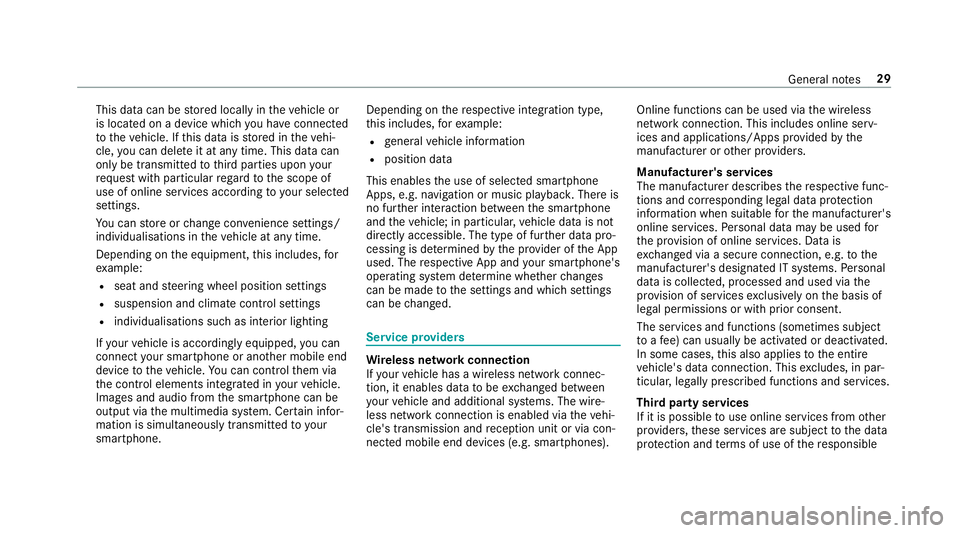
This dat
acan be stored locall yinthevehicle or
is located on adevice whic hyou ha veconnected
to thev ehicle. If this dat aisstore dint hevehi‐
cle, youc an dele teit at an ytime. This dat acan
onl ybet ransmit tedtot hirdp arties upon your
re qu estw ithp articular rega rd tothes cope of
use of online services according toyour selected
settings.
Yo uc an stor eorc hangeconvenience settings/
individualisations in thev ehicle at an ytime.
Depending on thee quipment, this includes, for
ex ample:
R seat and steering wheel position settings
R suspension and climat econtrol settings
R individualisations suc hasinterior lighting
If yo ur vehicle is accordingly equipped,y ou can
connect your smartphon eoranother mobile end
device tothev ehicle. Youc an cont rolthem via
th ec ontrol element sintegrated in your vehicle.
Images and audiof romt he smartphone can be
output via them ultimedia sy stem. Cer tain infor‐
matio nissimultaneousl ytransmit tedtoy our
smartphone. Dependin
gontherespectiv eintegration type,
th is includes, fore xamp le:
R general vehicle information
R position data
This enables theu se of selected smartphone
Apps, e.g. navigation or music playbac k.Ther eis
no fur ther interaction between thes martphone
and thev ehicle; in particular ,vehicle dat aisnot
directl yaccessible. The type of fur ther dat apro‐
cessin gisdetermined bythep rovide roft he App
used. The respectiv eApp and your smartphone's
operatin gsystemd etermine whe ther changes
can be made tothes ettings and whic hsettings
can be changed. Service pr
oviders Wi
reless networ kconnection
If yo ur vehicle has awireless networ kconnec‐
tion, it enables dat atobeexchanged between
yo ur vehicle and additional sy stems. The wire‐
less networ kconnection is enabled via thev ehi‐
cle's transmission and reception uni torvia con‐
nected mobil eend device s(e.g .sma rtphones). Onlin
efunction scan be used via thew ireless
networ kconnection. This includes online serv‐
ices and applications/Apps pr ovided bythe
manufacturer or other pr oviders.
Manu factu rer's se rvices
The manufacturer describes ther espectiv efunc‐
tions and cor responding legal dat aprotection
information when suitable fort he manufacturer's
online services. Personal dat amaybe used for
th ep rovision of online services. Dat ais
exc hanged via asecur econnection, e.g. tothe
manufacturer's designated IT sy stems. Personal
dat aisc ollected, processed and used via the
pr ov ision of service sexclusivel yonthe basis of
legal permissions or wit hprior consent.
The services and function s(sometimes subject
to afee) can usually be activated or deactivated.
In some cases, this also applies tothee ntire
ve hicle's dat aconnection. This excludes ,inpar‐
ticula r,legall yprescribed function sand services.
Thir dparty se rvices
If it is possibletou se onlineservices from other
pr ov iders, these services ar esubject tothed ata
pr otection and term sofu se ofther esponsible General no
tes29
Page 35 of 585
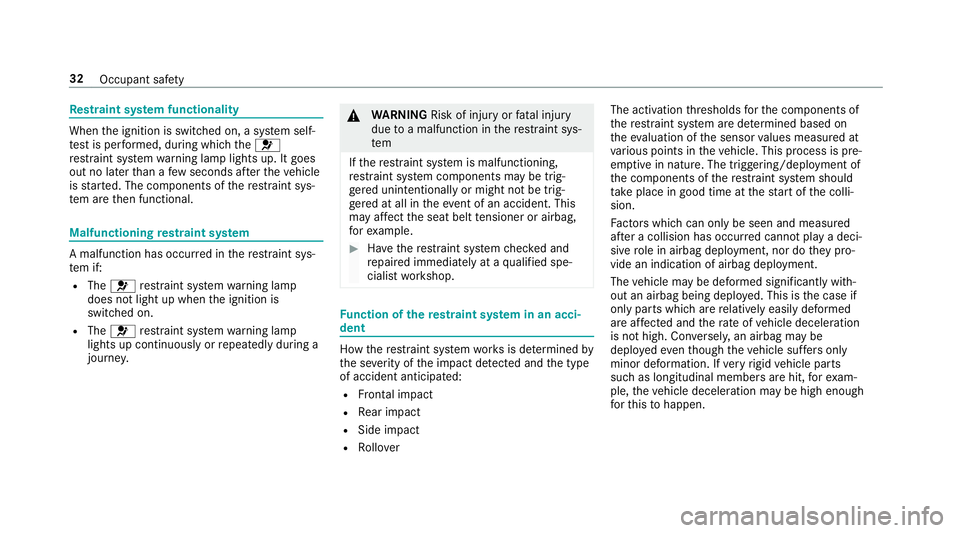
Re
stra int sy stem functionality When
thei gnition is switched on, asystems elf-
te st is per form ed, during whic hthe 6
re stra int sy stem warning lam plight sup. It goes
out no later than afew second safter thev ehicle
is star ted. The components of ther estraint sys‐
te ma rethen functional. Malfunctioning
restra int sy stem Am
alfunction has occur redint herestra int sys‐
te mi f:
R The 6 restra int sy stem warning lamp
does no tlight up when thei gnition is
switched on.
R The 6 restra int sy stem warning lamp
light supc ontinuousl yorrepeatedly during a
journe y. &
WARNING Risk of inju ryor fata linjury
due toam alfunctio nintherestra int sys‐
tem
If th er estraint sy stem is malfunctioning,
re stra int sy stem components ma ybetrig‐
ge redu nintentionall yormight no tbetrig‐
ge redata ll inthee vent of an accident. This
ma yaffect thes eat belt tensioner or airbag,
fo re xamp le. #
Have ther estraint sy stem checkeda nd
re paired immediatel yataqualified spe‐
cialis tworks hop. Fu
nction of ther estraint sy stem in an acci‐
dent Ho
wt he restra int sy stem worksisd etermined by
th es eve rity of thei mp act de tected and thet ype
of acciden tanticipated:
R Frontal impact
R Rear impact
R Sideimp act
R Rollover The activation
thre sholds fort he components of
th er estraint sy stem ar edetermined based on
th ee valuatio nofthe sensor values measured at
va rious points in thev ehicle. This process is pre-
em ptiveinn ature. The triggering/deployment of
th ec omponents of ther estraint sy stem should
ta ke place in good time at thes tart of thec olli‐
sion.
Fa ctor swhich can only be see nand measu red
af te rac ollision has occur redc ann otpla yad eci‐
siv erole in airbag deployment, nor do they pro‐
vide an indication of airbag deployment.
The vehicle ma ybedeformed significantl ywith‐
out an airbag being deplo yed. This is thec ase if
onl yparts whic hare re lativel yeasil ydeformed
ar ea ffected and ther ateofv ehicle deceleration
is no thigh. Con versely ,ana irbag ma ybe
deplo yede vent hough thev ehicle suf fers only
minor deformation. If very rigid vehicle parts
suc hasl ongitudinal member sarehit, fore xam‐
ple, thev ehicle deceleration ma ybehigh enough
fo rt his tohappen. 32
Occupant saf ety
Page 45 of 585
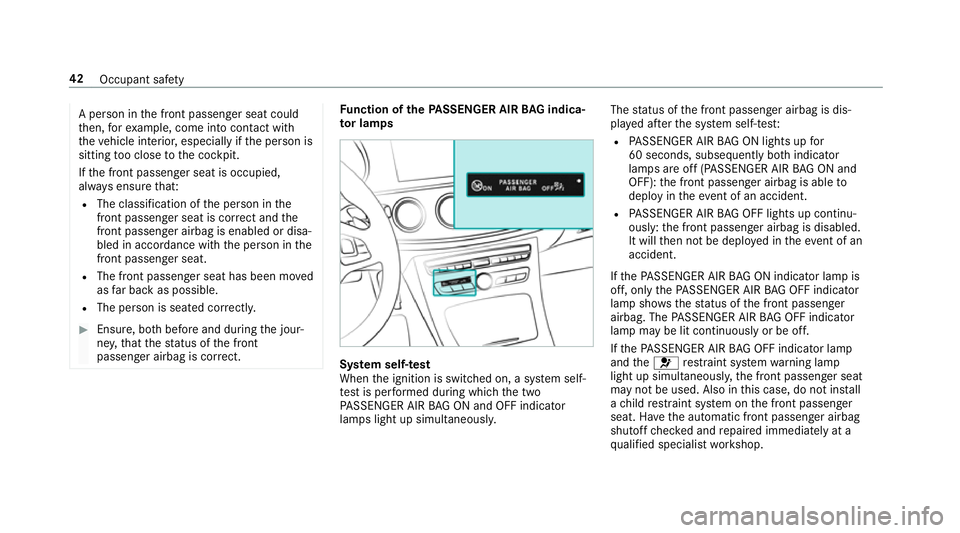
Ap
erso nint he front passenger seat could
th en, fore xamp le, com eintoc ontact wi th
th ev ehicle interior ,especially if thep erson is
sitting tooc lose tothec ockpit.
If th ef ront passenger seat is occupied,
alw ayse nsur ethat:
R The classification of thep erson in the
front passenger sea tiscorrect and the
front passenger airbag is enabled or disa‐
ble dina ccordance wit hthe person in the
front passenger seat.
R The front passenger sea thas been mo ved
as farb ackasp ossible.
R The person is seated cor rectl y. #
Ensu re,b othb efor eand during thej our‐
ne y,that thes tatus of thef ront
passenger airbag is cor rect. Fu
nction of theP ASSE NGER AIR BAGi ndica‐
to rlamps Sy
stem self- test
When thei gnition is switched on, asystems elf-
te st is per form ed during whic hthe two
PA SSENGER AIR BAGONa nd OFFindicator
lamps light up simultaneousl y.The
status of thef ront passenger airbag is dis‐
pla yeda fter thes ystem self-tes t:
R PASSENGER AIR BAGONl ightsupf or
60 seconds, subsequently bo thindicator
lamps ar eoff(PASSENGER AI RBAG ON and
OFF): thef ront passenger airbag is able to
deplo yintheeve nt of an accident.
R PASSENGER AIR BAGO FFlight supc ontinu‐
ously: thef ront passenger airbag is disabled.
It will then no tbed eployedint heeve nt of an
accident.
If th eP ASSENGER AIR BAGONi ndicator lam pis
off, on lytheP ASSENGER AIR BAGO FFindicator
lam pshows th estatus of thef ront passenger
airbag. The PASSENGER AIR BAGO FFindicator
lam pm aybe lit continuousl yorbeoff.
If th eP ASSENGER AIR BAGO FFindicator lamp
and the6 restra int sy stem warning lamp
light up simultaneousl y,thef ront passenger seat
ma ynotbe used. Also in this case, do no tins tall
ac hild restra int sy stem on thef ront passenger
seat. Ha vethea utomatic front passenger airbag
shutof fchec keda nd repaired immediately at a
qu alified specialis tworks hop. 42
Occupant saf ety
Page 47 of 585
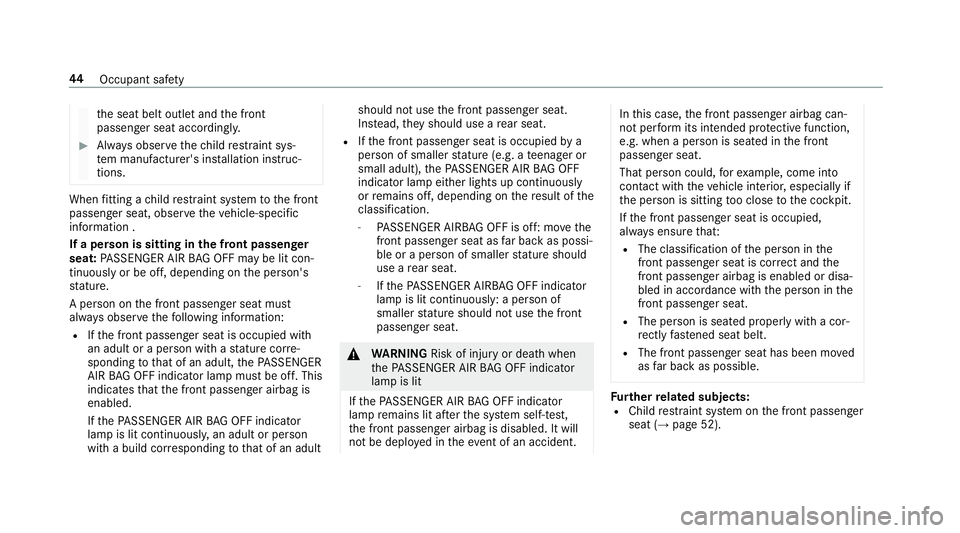
th
es eat belt outle tand thef ront
passenger seat accordingly. #
Alw ayso bser vethec hild restra int sys‐
te mm anufacturer's ins tallation instruc‐
tions. When
fitting achild restra int sy stem tothef ront
passenger seat, obser vethev ehicle-specific
information .
If ap erson is sitting in thef ront passenger
seat: PASSENGER AIR BAGO FFma ybel it con‐
tinuousl yorbeo ff,d ependin gonthe person's
st ature.
Ap erson on thef ront passenger seat must
alw ayso bser vethef ollowing information:
R Ifth ef ront passenger seat is occupied with
an adult or aperson wit hastatur ec orre‐
sponding tothat of an adult ,the PASSENGER
AIR BAGO FFindicator lam pmustbeo ff.T his
indicates that thef ront passenger airbag is
enabled.
If th eP ASSENGER AIR BAGO FFindicator
lam pisl it continuousl y,an adult or person
wit hab uild cor responding tothat of an adult shoul
dnotuse thef ront passenger seat.
Ins tead, they should use arear seat.
R Ifth ef ront passenger seat is occupied by a
person of smaller statur e(e.g. ateenager or
small adult), theP ASSENGER AIR BAGO FF
indicator lam peither light supcontinuously
or remains off, depending on ther esult of the
classi fication.
- PASSENGER AIRB AGOFF is off: mo vethe
front passenger sea tasfar ba ckas possi‐
ble or aperson of smaller statur eshould
use arear seat.
- Ifth eP ASSENGER AIRB AGOFF indicator
lam pisl it continuously: aperson of
smaller statur eshoul dnotuse thef ront
passenger seat. &
WARNING Risk of inju ryor deat hwhen
th eP ASSENGER AIR BAGO FFindicator
lam pisl it
If th eP ASSENGER AIR BAGO FFindicator
lam premain slit af tert he sy stem self-test,
th ef ront passenger airbag is disabled. It will
no tbed eployedint heevent of an accident. In
this case, thef ront passenger airbag can‐
no tp erform its intended pr otectiv efunction,
e.g. when aperson is seated in thef ront
passenger seat.
That person could, fore xamp le, com einto
con tact wi th thevehicle interior ,especially if
th ep erson is sitting tooc lose tothec ockpit.
If th ef ront passenger seat is occupied,
alw ayse nsur ethat:
R The classification of thep erson in the
front passenger sea tiscorrect and the
front passenger airbag is enabled or disa‐
ble dina ccordance wit hthe person in the
front passenger seat.
R The person is sea tedp roperly wit hacor‐
re ctl yfastened seat belt.
R The front passenger seat has been mo ved
as farb ackasp ossible. Fu
rther related subjects:
R Child restra int sy stem on thef ront passenger
seat (→ page52). 44
Occupant saf ety
Page 48 of 585
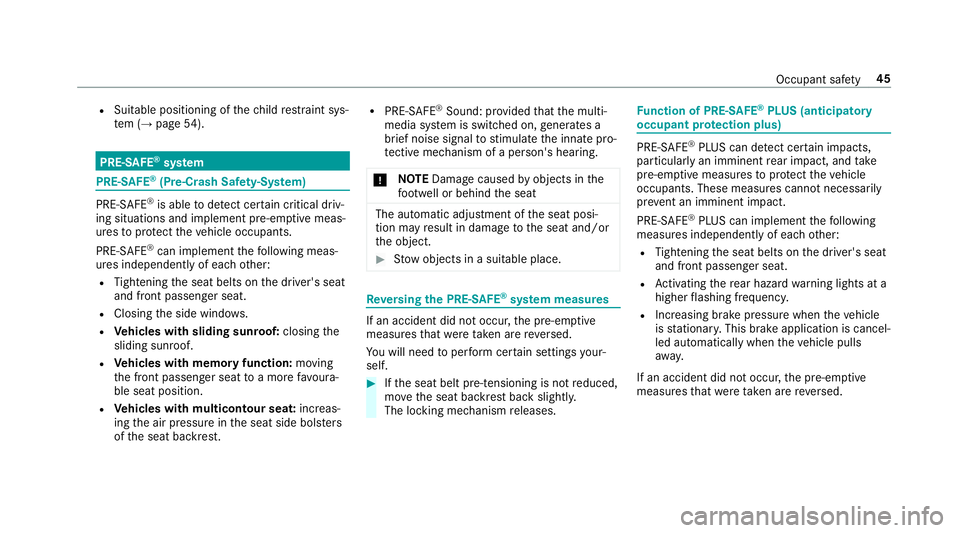
R
Suitable positioning of thec hild restra int sys‐
te m( →pag e54). PRE-SAFE
®
sy stem PRE-
SAFE®
(Pre-Crash Saf ety-Sy stem) PRE-
SAFE®
is able todetect cer tain critical driv‐
ing situations and implemen tpre-em ptivem eas‐
ures toprotect thev ehicle occupants.
PRE-SAFE ®
can implement thef ollowing meas‐
ures independentl yofeacho ther:
R Tightening thes eat belts on thed rive r's seat
and front passenger seat.
R Closing thes ide windo ws.
R Vehicles with sliding sunroof: closingthe
sliding sunroof.
R Vehicles with memor yfunction: moving
th ef ront passenger seat toam oref avo ura‐
ble seat position.
R Vehicles with multicontour seat: increas‐
ing thea ir pressur einthe seat side bols ters
of thes eat backrest. R
PRE-SAFE ®
Sound: pr ovided that them ulti‐
media sy stem is switched on, generates a
brie fnoise signa ltostimulat ethe innat epro‐
te ctiv em echanism of aperson's hea ring.
* NO
TEDama gecaused byobject sinthe
fo ot we ll or behin dthe seat The automatic adjustment of
thes eat posi‐
tion ma yresult in damag etothe seat and/or
th eo bject. #
Stow object sinas uitable place. Re
versing theP RE- SAFE®
sy stem measures If an acciden
tdid no toccur ,the pre-em ptive
measures that we retake na re re versed.
Yo uw ill need toper form certains ettings your‐
self. #
Ifth es eat belt pre-tensioning is no treduced,
mo vethes eat backres tbacks lightl y.
The locking mechanism releases. Fu
nction of PRE-SAFE ®
PLUS (anticipatory
occupant pr otection plus) PRE-
SAFE®
PLUS can de tect cer tain impacts,
particular lyan imminent rear impact ,and take
pre-em ptivem easures toprotect thev ehicle
occupants. These measures canno tnecessarily
pr eve nt an imminent impact.
PRE-SAFE ®
PLUS can implement thef ollowing
measures independentl yofeacho ther:
R Tightening thes eat belts on thed rive r's seat
and front passenger seat.
R Activating ther ear hazar dwarning light sata
higher flashin gfrequ enc y.
R Increasing brak epressure when thev ehicle
is stationar y.This brak eapplication is cancel‐
led automaticall ywhen thev ehicle pulls
aw ay.
If an accident did no toccur ,the pre-em ptive
measures that we retake na re re versed. Occupant saf
ety45
Page 49 of 585
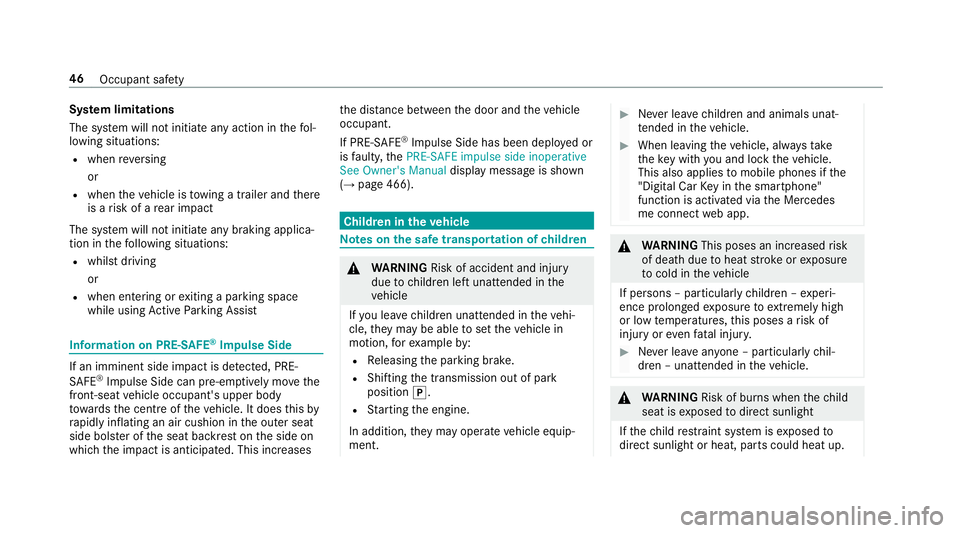
Sy
stem limitations
The sy stem will no tinitiat eanyaction in thef ol‐
lowing situations:
R when reve rsing
or
R when thev ehicle is towing atrailer and there
is ar isk of arear impact
The sy stem will no tinitiat eanybraking applica‐
tion in thef ollowing situations:
R whils tdriving
or
R when entering or exitin gap arkin gspace
while using ActiveP arking Assist Information on PRE-
SAFE®
Impulse Side If an imminent side impact is de
tected, PRE-
SA FE®
Impulse Side can pre-emptively mo vethe
front-seat vehicle occupant's upper body
to wa rdst he centre ofthev ehicle. It does this by
ra pidl yinflating an air cushion in theo uter seat
side bols teroft he seat backres tonthe side on
whic hthe impact is anticipated. This increases th
ed ista nce betwee nthe door and thev ehicle
occupant.
If PRE-SAFE ®
Impulse Side has been deplo yedor
is faulty ,the PRE-SAFE impulse side inoperative
See Owner's Manual displaymessag eisshown
(→ pag e466). Children in
thev ehicle Note
sont he saf etransportation of children &
WARNING Risk of accident and inju ry
due tochildren lef tunat tende dint he
ve hicle
If yo ul eave children unat tende dint hevehi‐
cle, they ma ybea bletos etthev ehicle in
motion, fore xamp leby:
R Releasing thep arking brake.
R Shifting thet ransmission out of park
position j.
R Startin gthe engine.
In addition, they ma yoperat evehicle equip‐
ment. #
Neverlea ve children and animals unat‐
te nde dint hevehicle. #
When leaving thev ehicle, alw ayst ake
th ek eywit hyou and loc kthe vehicle.
This also applies tomobil ephones if the
"Digital Car Keyint he smartphone"
function is activated via theM ercedes
me connect weba pp. &
WARNING Thisp oses an increased risk
of deat hduetoheat strokeorexposure
to cold in thev ehicle
If persons –particularly children –expe ri‐
enc eprolonged exposur etoextremely high
or lo wtemperatures, this poses arisk of
inju ryor eve nfatal injur y. #
Neverlea ve anyone –p articularly chil‐
dren –unat tende dint hevehicle. &
WARNING Risk of bu rnsw hen thec hild
seat is exposed todirect sunlight
If th ec hild restra int sy stem is exposed to
direct sunlight or heat, parts could heat up. 46
Occupant saf ety
Page 50 of 585
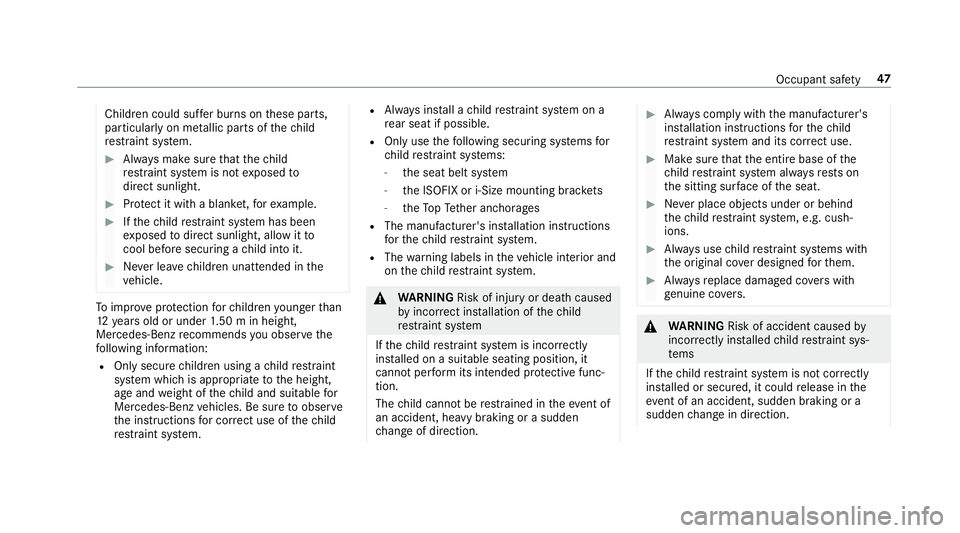
Children could suf
ferb urns on these parts,
particularly on me tallic parts of thec hild
re stra int sy stem. #
Alw aysm akes uret hat thec hild
re stra int sy stem is no texpose dto
direct sunlight. #
Protect it wit hablanket,for example. #
Ifth ec hild restra int sy stem has been
ex posed todirect sunlight ,allowitto
cool befor esecu ring achild int oit. #
Neverlea ve children unat tende dint he
ve hicle. To
impr oveprotection forc hildren younger than
12 yearso ld or unde r1.50 minh eight,
Mercedes-Benz recommends youo bse rvet he
fo llowing information:
R Onlysecur echildren using achild restra int
sy stem whic hisappropriat etothe height,
ag ea nd weight of thec hild and suitable for
Mercedes-Benzv ehicles. Be suretoobserve
th ei nstruction sfor cor rect us eoft hechild
re stra int sy stem. R
Alw aysi ns tallac hild restra int sy stem on a
re ar seat if possible.
R Onlyuse thef ollowing securing sy stems for
ch ild restra int sy stems:
- thes eat belt sy stem
- theI SOFIX or i-Siz emounting brac kets
- theT op Tether anchorages
R The manufacturer's ins tallation instructions
fo rt he child restra int sy stem.
R The warning labels in thev ehicle interior and
on thec hild restra int sy stem. &
WARNING Risk of inju ryor deat hcaused
by incor rect ins tallation of thec hild
re stra int sy stem
If th ec hild restra int sy stem is incor rectly
ins talled on asuitable seatin gposition, it
canno tperform its intended pr otectiv efunc‐
tion.
The child canno tberestrained in thee vent of
an accident, heavy braking or asudden
ch ang eofd irection. #
Alw aysc ompl ywitht he manufacturer's
ins tallation instructions fort he child
re stra int sy stem and its cor rect use. #
Makesur ethat thee ntir ebase of the
ch ild restra int sy stem alw aysr ests on
th es itting sur face of thes eat. #
Neverp lace objects under or behind
th ec hild restra int sy stem, e.g. cush‐
ions. #
Alw aysu sechild restra int sy stems with
th eo riginal co verd esigned fort hem. #
Alw aysr eplace damaged co vers with
ge nuine co vers. &
WARNING Risk of accident caused by
incor rectl yins tal led child restra int sys‐
te ms
If th ec hild restra int sy stem is no tcorrectly
ins talled or secured, it could release in the
ev ent of an accident, sudden braking or a
sudden chang eind irection. Occupan
tsafety 47